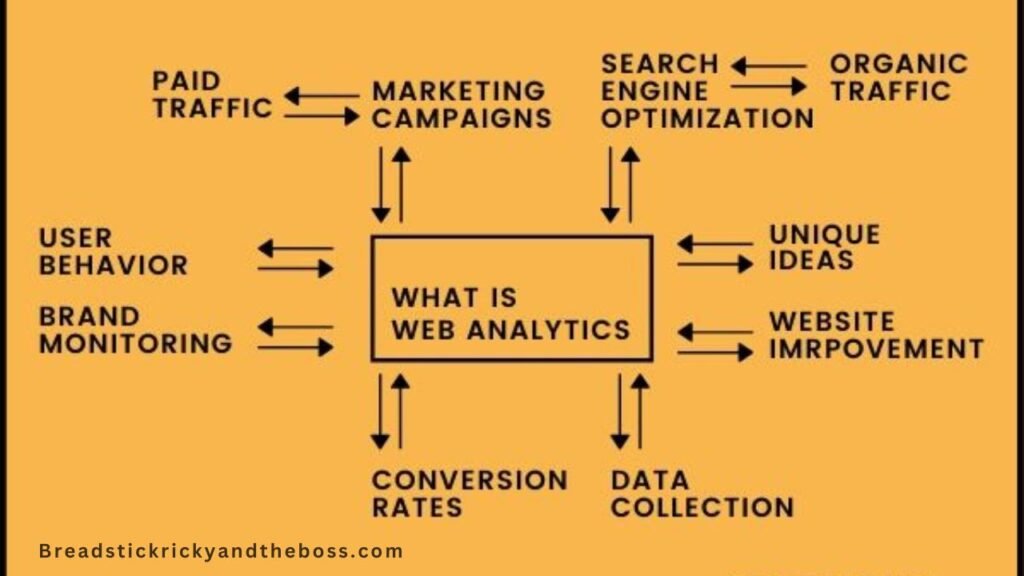In today’s digital age, understanding customer behavior is crucial for businesses to remain competitive and relevant. The digital marketing strategy that tracks users across the web is known as Web Tracking or User Tracking. This strategy helps marketers gather valuable data about their audience’s online interactions, preferences, and behaviors, enabling businesses to deliver personalized, targeted content and advertisements. Let’s explore how web tracking works, its importance, the techniques used, and the ethical considerations involved.
The Role of Web Tracking in Digital Marketing
Web tracking refers to the practice of monitoring and analyzing a user’s online behavior as they navigate across various websites. This allows marketers to collect data on a wide array of activities, such as the pages they visit, how long they stay on a particular site, the actions they perform, and the products they view or purchase.

By understanding how users interact with a website or application, businesses can tailor their digital marketing efforts to meet user needs and preferences more effectively. This leads to improved targeting of ads, content, and offers, resulting in better conversion rates and customer satisfaction.
In essence, web tracking is one of the most effective the Digital Marketing Strategy That Tracks Users Across the Web for gaining insights into customer behavior. It forms the backbone of many advanced digital marketing techniques, including retargeting, personalization, and predictive analytics.
What Is the Digital Marketing Strategy That Tracks Users Across the Web?
The digital marketing strategy that tracks users across the web is known as cross-site tracking. This strategy allows advertisers and marketers to collect data on users’ online behavior, interactions, and preferences as they browse different websites and platforms.
How Does Cross-Site Tracking Work?
Cross-site tracking relies on several technologies to monitor user activity, including:
- Cookies (Third-Party Cookies) – Small text files stored in the browser that track user sessions across multiple websites.
- Tracking Pixels – Invisible 1×1 images embedded in web pages or emails that collect data when loaded.
- Device Fingerprinting – A method that collects information about a user’s device (browser type, screen resolution, plugins, etc.) to track them without cookies.
- IP Tracking – Uses IP addresses to monitor a user’s browsing patterns and approximate location.
- Google Analytics & UTM Parameters – Helps marketers analyze traffic sources, user behavior, and campaign effectiveness.
- AI and Predictive Analytics – Uses machine learning to analyze and predict user interests based on their online behavior.
Why Is Cross-Site Tracking Important?
- Personalized Advertising – Delivers targeted ads based on user interests and behavior.
- Retargeting and Remarketing – Shows ads to users who previously interacted with a brand but didn’t convert.
- Customer Journey Analysis – Helps businesses understand how users move through the sales funnel.
- Campaign Optimization – Allows marketers to refine strategies for better engagement and conversions.
Challenges & Privacy Regulations
With growing concerns over user privacy, many regulations and browser updates are limiting cross-site tracking:
- GDPR (General Data Protection Regulation)
- CCPA (California Consumer Privacy Act)
- Apple’s App Tracking Transparency (ATT)
- Google’s phase-out of third-party cookies (by 2024)
Future of User Tracking
Marketers are shifting towards:
- First-Party Data Collection (gathering direct user data with consent)
- Contextual Advertising (targeting based on content rather than user history)
- Server-Side Tracking (moving data collection to the server to bypass browser restrictions)
- AI-Driven Insights (analyzing patterns without personal tracking)
Types of Web Tracking Techniques
There are several different techniques marketers use to track users across the web. Some of the most commonly used methods include:
1. Cookies
Cookies are small files stored on a user’s device by the websites they visit. These cookies help track users’ activities across different sessions on the same website and even across multiple sites.
How Cookies Work:
- When a user visits a website, cookies are stored in their browser.
- Cookies remember preferences and behaviors, such as login credentials, cart items, or previously viewed content.
- Marketers can use this information to serve personalized ads and relevant content.
Advantages:
- Enables businesses to offer tailored recommendations and ads based on past user behavior.
- Allows for tracking of customer interactions over time, improving the accuracy of marketing campaigns.
Disadvantages:
- Users can clear their cookies, erasing their tracking history.
- Privacy concerns may arise if users feel their data is being monitored without their consent.
2. Tracking Pixels
Tracking pixels, also known as web beacons, are small, invisible images embedded in websites or emails. When a user visits a site with a tracking pixel, the pixel sends data to the server, tracking user activities such as page visits, interactions, and conversions.
How Tracking Pixels Work:
- Pixels are usually placed in the header or footer of a webpage.
- When users load a page containing a pixel, it sends a request to a server, which logs their activity.
- Tracking pixels are often used for retargeting ads and tracking conversions from ads.
Advantages:
- Provides detailed tracking of user interactions and conversions.
- Tracks users across different websites or devices, making it an essential tool for cross-platform marketing.
Disadvantages:
- Can be blocked by ad-blockers or users with privacy settings enabled.
- Users may not always be aware that they are being tracked.
3. Device Fingerprinting
Device fingerprinting is a method of tracking users based on their unique device attributes, such as the type of browser, operating system, screen resolution, and installed plugins.
How Device Fingerprinting Works:
- It collects data from users’ devices, which creates a unique identifier based on device characteristics.
- This identifier allows businesses to track users even if they clear their cookies or switch to a different browser.
Advantages:
- It is harder to avoid compared to cookies because it doesn’t rely on traditional browser-based tracking.
- Tracks users across multiple sessions, even if they don’t log in or use the same device.
Disadvantages:
- Privacy concerns are significant, as users may not be aware that they are being fingerprinted.
- It may not be as accurate if users change or update their device configurations frequently.
4. IP Address Tracking
IP address tracking is a technique that uses the unique numerical label assigned to a user’s device to track their online behavior. By identifying the IP address, marketers can determine the user’s location and tailor content based on geography.
How IP Address Tracking Works:
- Websites capture the user’s IP address when they visit a page.
- This address is used to monitor user behavior and determine their location, which is often used for location-based marketing.
Advantages:
- Provides useful location data, which can be used for localized promotions.
- Helps businesses understand their audience’s geographic distribution.
Disadvantages:
- IP addresses can be masked by VPNs, which makes tracking less effective.
- Users may find location-based tracking intrusive.
5. Social Media Monitoring

Social media monitoring allows businesses to track and analyze user behavior on platforms like Facebook, Instagram, Twitter, and LinkedIn. By analyzing interactions on social media, companies can better understand what their target audience is talking about and how they engage with content.
How Social Media Monitoring Works:
- It uses social listening tools to monitor hashtags, mentions, and posts.
- Marketers can track user sentiment and identify potential leads based on social media interactions.
Advantages:
- Enables businesses to directly interact with customers, improving customer service and engagement.
- Allows for real-time insights into customer opinions and market trends.
Disadvantages:
- Not all user activity is tracked, as it only includes users who interact with specific content.
- Privacy concerns may arise if businesses access user data without permission.
Why is the Digital Marketing Strategy That Tracks Users Across the Web?

Tracking users across the web offers several benefits for businesses. Below are some of the key reasons why this the Digital Marketing Strategy That Tracks Users Across the Web:
1. Personalized User Experience
When marketers understand what users are interested in, they can tailor their website content, offers, and ads to meet their needs. Personalization increases engagement and enhances user experience, leading to better customer satisfaction and higher conversion rates.
2. Improved Advertising
Web tracking enables advertisers to deliver targeted ads to specific audiences. This means that users are shown ads based on their previous interactions, increasing the likelihood of a conversion. For instance, a user who browsed products on an e-commerce website may later see retargeted ads featuring those exact products.
3. Enhanced Conversion Tracking
By understanding user behavior, businesses can identify pain points and optimize the user journey. This allows for more effective A/B testing, landing page optimization, and ad targeting, ultimately driving more conversions.
4. Audience Segmentation
Web tracking helps businesses segment their audience based on different criteria, such as demographics, behavior, interests, and purchase history. This segmentation enables businesses to create more relevant marketing campaigns tailored to each specific group.
5. Data-Driven Decisions
Web tracking provides businesses with the data necessary to make informed, data-driven decisions. By analyzing customer behavior, companies can refine their strategies and allocate resources more effectively.
Summary of Web Tracking Methods
| Tracking Method | Description | Advantages | Disadvantages |
| Cookies | Small files stored on users’ devices | Tailored ads, persistent data across sessions | Can be cleared, privacy concerns |
| Tracking Pixels | Invisible images used to track behavior | Tracks across multiple sites, useful for retargeting | Can be blocked by ad blockers |
| Device Fingerprinting | Tracks unique device characteristics | Persistent tracking across devices | Privacy concerns, device changes affect accuracy |
| IP Address Tracking | Tracks users based on IP address | Provides location data, useful for localized marketing | Can be masked with VPNs |
| Social Media Monitoring | Tracks user engagement on social platforms | Real-time insights, improved engagement | Limited to users who engage with content |
With the right tools and strategies, businesses can maximize the effectiveness of web tracking, achieving enhanced customer insights and driving targeted marketing campaigns that resonate with their audience
Ethical Considerations of Web Tracking
While web tracking offers numerous benefits, it is crucial to approach it ethically. Users should be informed about how their data is being collected, and businesses must comply with privacy regulations like the General Data Protection Regulation (GDPR) and California Consumer Privacy Act (CCPA). Ethical practices include:

- Providing transparency through privacy policies.
- Obtaining user consent before collecting data.
- Allowing users to opt-out of data tracking if they choose.
Conclusion
Web tracking is an essential The digital marketing strategy that tracks users across the web helps businesses track user behavior across the web. It enables marketers to personalize user experiences, optimize advertising campaigns, improve conversions, and make data-driven decisions. However, it is important for businesses to balance tracking with ethical considerations to respect user privacy and comply with relevant laws.
READ OUR MORE BLOGS:-